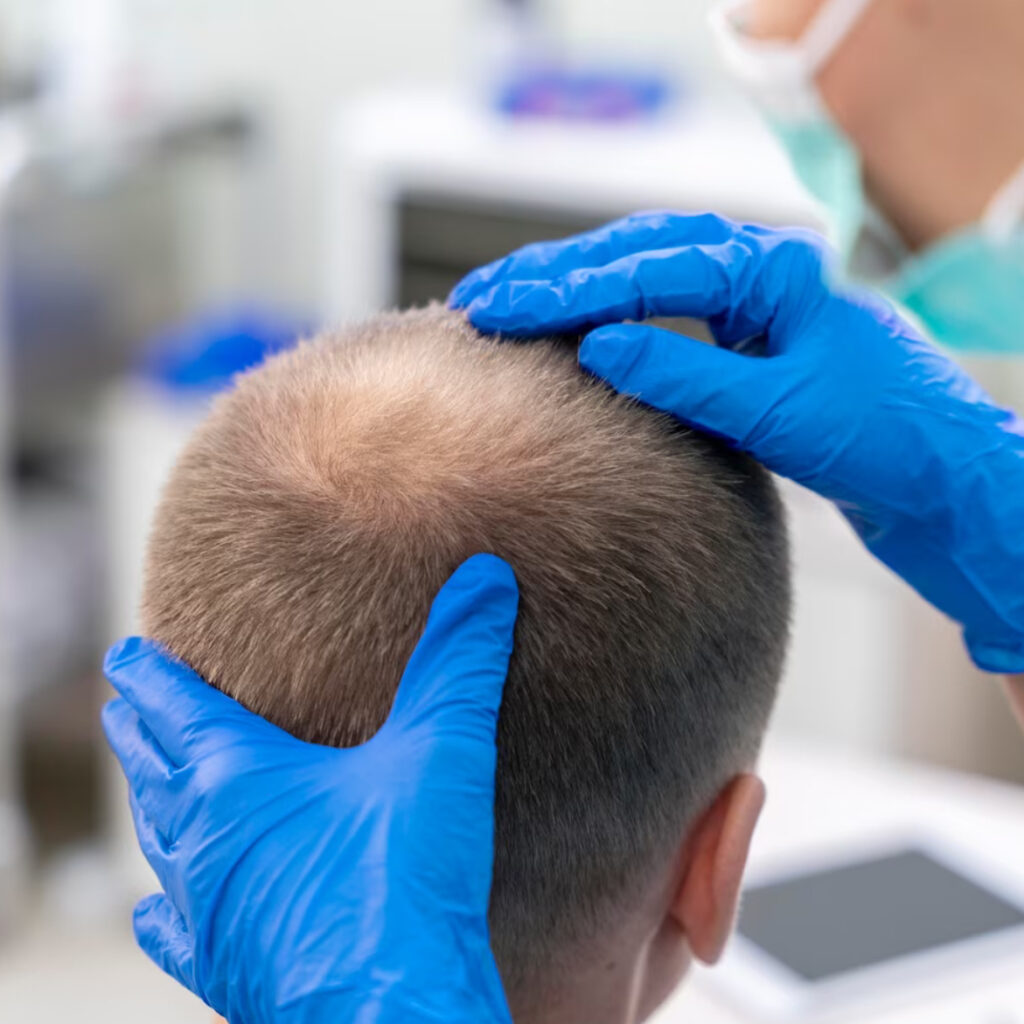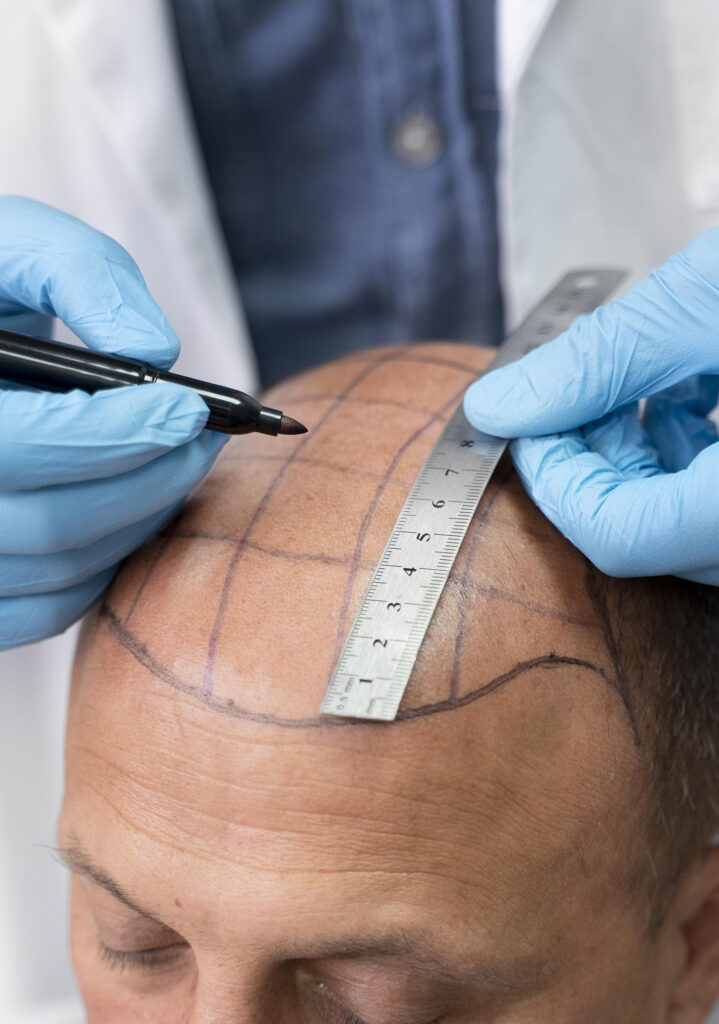- Contact-
- İnönü mahallesi, Gazi Mustafa Kemal Blv. Sitesi 1406 sokak No:14, 33130 Yenişehir/Mersin
- info@ankahairclinic.com
- Mon - Sat : 09:00/19:00
- +90 (555) 999 88 77
ANKAHAIR
Don't be afraid to give up the good to go for the great
Follicular Unit Extraction (FUE)
Follicular Unit Extraction (FUE) is a technique used in hair restoration surgery. With the FUE method, hair follicles are individually extracted from the donor area, typically located at the back or sides of the head, for hair transplantation. This procedure involves the precise removal of hair follicles one by one.

Follicular Unit Extraction (FUE) is a method used in hair restoration surgery where individual hair follicles are harvested from the donor area one by one. This procedure offers a significant advantage as it does not leave a linear scar, allowing patients to wear short hairstyles after recovery, which is a common drawback of the FUT (Follicular Unit Transplantation) hair transplantation process.
FUE hair transplant is a minimally invasive procedure that involves making only microscopic incisions and requires no stitches. Instead of removing a strip of scalp and using sutures, individual hair follicles are meticulously extracted using a small, punch-like device. This approach leads to faster healing and less discomfort in the donor area post-surgery.
Furthermore, in contrast to strip harvesting, which results in a noticeable linear scar, FUE hair transplant leaves small, dot-like incisions that are much less conspicuous. These scars are scattered across the donor area and can be easily concealed, even when opting for shorter hairstyles. Finally, for individuals with a tight scalp, a linear technique can be challenging, especially if they have undergone multiple FUT procedures in the past. In such cases, FUE may be a viable alternative since it does not require the removal of a scalp strip.

How is FUE Hair Transplantation Done?
The procedure starts with cleaning and sterilizing the patient’s scalp at AnkaClinic. The donor area, generally at the rear or rear of the scalp, is then marked by the surgeon, wherein hair follicles that are in good health will be plucked. The donor region and the location of the recipient (where the hair will be transplant) are then anesthetized. This guarantees that the treatment is painless and that the patient is comfortable throughout. Following this, the surgeon harvests individual follicles of hair from the donor area using specialized micro instruments. These follicles have been carefully chosen for their quality and translatability. FUE involves pulling a single follicle at a time, creating small puncture marks, which heal without leaving visible scars.
After extracting the requisite number of follicles, the surgical team methodically prepares the retrieved grafts for transplantation. Sorting and inspecting the follicles under a magnifying lens to guarantee their integrity is required. After all of this, the medical professional makes tiny cuts or breaches in the intended area, following the usual hair growth pattern. The recipient sites’ design is critical for getting a natural-looking effect. The newly prepared grafts are then carefully implanted one by one into the recipient areas. The expertise and attention to detail of the surgeon guarantee that the newly grown hair blends in with the existing hair, replicating natural growth patterns.
Advantages of Fue Hair Transplantation
“FUE hair transplant offers several advantages, including reduced scarring, a more natural appearance, and lower invasiveness. However, it does come with drawbacks such as higher costs, longer operation durations, and potential graft yield limitations. Consequently, the decision to opt for FUE should be based on an individual’s personal preferences, hair loss pattern, and the expertise of the surgical team. A comprehensive consultation with a professional surgeon can help individuals make an informed choice regarding the most suitable hair transplant approach for their specific situation.
The advantages of FUE hair transplant can be listed as follows:
FUE involves harvesting individual hair follicles one at a time, resulting in small puncture wounds that heal quickly and leave minimal scarring. This makes it a popular choice for those who prefer to maintain short hair.
The meticulous FUE technique allows for the transplantation of individual hair follicles, mimicking the natural growth pattern. As a result, the outcome appears more natural with no visible traces of surgical intervention.
FUE is less invasive than traditional strip methods as it does not require a linear incision. This can lead to quicker recovery and less post-operative discomfort.”
Disadvantages of Fue Hair Transplantation
Selecting the right clinic for your FUE hair transplantation is a critical decision, as an inexperienced team can lead to various disadvantages:
Time-Consuming Procedure: FUE, being a meticulous technique where each follicle is harvested individually, can extend the overall procedure time, especially during extensive transplant sessions.
Higher Procedure Costs: The precision and expertise required for successful FUE implementation can result in higher procedure expenses when compared to alternative methods.
Potential Graft Yield Issues: Inexperienced surgeons performing FUE may lead to a lower graft yield in comparison to alternative techniques.
Risk of Follicle Damage: There’s a risk of damaging hair follicles during the extraction process, reducing the chances of transplanted hair survival.
Limited Suitability: FUE may not be the optimal choice for individuals with significant baldness or those requiring a large number of grafts, as it may not provide sufficient donor hair.

Why Türkiye for Hair Transplantation?
Selecting Turkey as your destination for FUE hair transplantation offers a combination of factors that create an exceptional experience for patients. Turkey represents a convergence of excellence and accessibility in the field of FUE hair transplantation, encompassing skilled medical professionals, state-of-the-art facilities, cost-effectiveness, and personalized treatment plans.
Compared to alternative locations, Turkey is renowned for its ability to perform larger graft sessions in a single procedure. This results in comprehensive coverage within a shorter timeframe, reducing the need for multiple treatments and potentially lowering overall patient expenses.
Turkey boasts a well-established infrastructure for medical tourism, with numerous clinics offering comprehensive packages that encompass accommodation, transportation, and post-operative care. This ensures a seamless experience for international patients who choose Turkey for their FUE procedures.”
These revisions aim to enhance the SEO-friendliness of the content by incorporating relevant keywords and optimizing the text structure for improved search engine visibility
Turkey’s hair transplant clinics excel in providing personalized treatment plans that cater to the unique needs of each patient. Seasoned surgeons take into account factors like hair loss patterns, donor site availability, and aesthetic preferences, crafting bespoke plans that yield natural and individualized results.
The cost-effectiveness of FUE hair transplant procedures in Turkey serves as a compelling attraction for international patients. The fees for top-tier treatments in Turkey are often significantly lower than those in many Western countries. This cost advantage empowers patients to access premium hair transplant services without compromising on quality.
In summary, Turkey boasts a substantial number of highly skilled and experienced medical specialists who specialize in hair transplant procedures. These practitioners are renowned for their expertise and proficiency in advanced FUE techniques, ensuring precision, minimal scarring, and optimal graft survival. Turkey stands as a hub for cutting-edge FUE procedures, driven by a blend of medical innovation and state-of-the-art technology. Turkish clinics frequently feature state-of-the-art facilities equipped with the latest advancements in hair transplantation technology. These facilities underscore Turkey’s commitment to providing patients with exceptional treatment environments, encompassing innovative graft extraction equipment and modern imaging and graft insertion techniques.

Why is hair transplantation affordable in Turkey?
Compared to select Western countries, Turkey enjoys a cost advantage in terms of operational expenses, encompassing clinic overhead and employee costs. This financial advantage translates into more budget-friendly prices for FUE hair transplant procedures, all while upholding treatment quality. Additionally, the competitive landscape of the Turkish hair transplant market compels clinics to offer high-quality services at competitive rates. The substantial demand for FUE treatments in Turkey has fostered a robust industry, marked by a diverse array of clinics, fostering a competitive atmosphere that ultimately benefits patients with reduced costs.
Turkey’s reputation as a medical tourism hub has led to an influx of patients, resulting in economies of scale for clinics. With a higher volume of procedures, clinics can distribute fixed costs across multiple patients, effectively lowering the financial burden on individuals.
Many Turkish clinics offer comprehensive packages that encompass accommodations, transportation, and post-operative care, streamlining the patient experience and reducing overall expenses. This strategic marketing approach further enhances Turkey’s appeal as a medical tourism destination.
In summary, the affordability of FUE hair transplant treatments in Turkey arises from a combination of factors, including the experience of medical experts, lower operational costs, competition-driven pricing, economies of scale, and innovative packaging. This cost-effectiveness does not, in any way, compromise quality. Instead, it underscores Turkey’s commitment to making top-notch hair transplant procedures accessible to a broader audience, establishing the country as an attractive and financially feasible choice for those seeking FUE hair transplants.
Before FUE Hair Transplantation
- Before undergoing an FUE hair transplant, it’s crucial to be well-prepared and informed about the process. There are specific guidelines you should follow, and certain actions you should avoid in the lead-up to your procedure. Here are some valuable tips from the experts at Turkey Hair Center:
Avoid Smoking: Refrain from smoking for at least one day before your surgery. Smoking can hinder the body’s healing process.
Limit Alcohol Consumption: Avoid alcohol for a minimum of three days prior to your procedure, as alcohol can affect blood clotting and increase the risk of bleeding.
Medication Adjustments: Do not take ibuprofen or any blood-thinning medications for at least two weeks before your surgery to minimize the risk of excessive bleeding.
Nutritional Supplements: Cease taking any medications or nutritional supplements at least two weeks before your procedure, as some substances may interfere with the surgical process.
Antidepressants: If you are on antidepressants, discuss their use with your surgeon at least two weeks before surgery, as some medications may need to be adjusted.
Hair Length: Avoid cutting your hair right before the procedure, as longer hair can provide better coverage post-transplant.
Scalp Massage: In the weeks leading up to your surgery, consider massaging your scalp for approximately ten to thirty minutes daily. This can improve blood circulation to the scalp and enhance overall hair health.
Prescribed Medications: Follow any medications prescribed by your surgeon, such as minoxidil (Rogaine), to support the transplant process.
Medical Tests: Before the surgery, your surgeon may recommend an electrocardiogram (EKG) and blood tests to ensure you are in optimal health for the procedure.
By adhering to these guidelines, you can better prepare yourself for a successful FUE hair transplant and maximize your chances of achieving desired results. Always consult with your medical professional for personalized pre-operative instructions.
After FUE Hair Transplantation
After undergoing an FUE hair transplant, it’s essential to understand what to expect in the days and weeks following the procedure. Some common post-transplant experiences include:
Signs of Healing: You may notice signs of healing such as mild drainage, crust formation at the surgical site, and some swelling or discomfort around the transplant area.
Follicle Changes: It’s common for transplanted hair follicles to initially swell before settling into their new growth phase.
Bleeding and Sensations: Some patients may experience minor bleeding from the surgery site and sensations of tingling or numbness near the transplant area.
Hair Characteristics: The transplanted hair may initially appear different from your existing hair. This can be temporary as the transplanted hair adjusts and grows.
Continued Thinning: In some cases, hair thinning may persist even after the transplant has been completed.
Following the procedure, here are important post-operative tips recommended by AnkaClinic professionals:
Hair Washing: Avoid washing your hair or taking a shower for at least three days after the surgery.
Shampoo Selection: When you start shampooing your hair, opt for gentle, odorless shampoos for several weeks to ensure a gentle cleansing process.
Rest and Recovery: Allow yourself a few days off from work to facilitate the healing process.
Avoid Combing or Massaging: For a minimum of three weeks, refrain from combing or massaging your newly transplanted hair to avoid disrupting the grafts.
Head Coverings: Unless advised otherwise by your doctor, it’s generally not recommended to wear hats, beanies, or similar head coverings during the initial recovery phase.
Physical Activity: Avoid engaging in strenuous physical activities for at least a week after the procedure to prevent excessive sweating and potential irritation to the transplant area.
By following these guidelines, you can promote successful healing and optimize the results of your FUE hair transplant. It’s important to consult with your medical professional for personalized post-operative care instructions.
